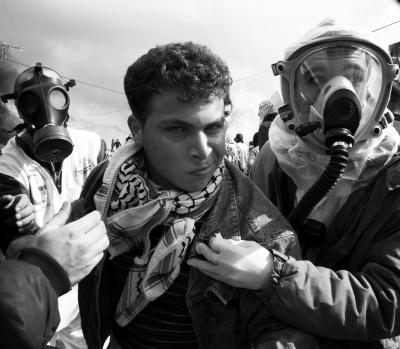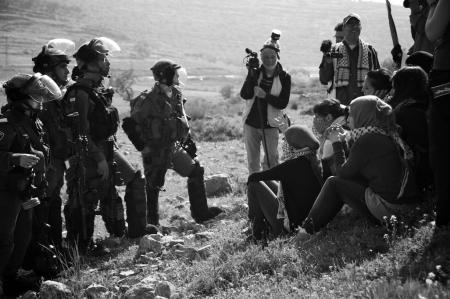Ramallah. In November 2012, the United Nations General Assembly approved a resolution to upgrade Palestine to a “nonmember observer state”. The usual suspects—Israel, their American financers, and a few of their mutual allies—voted against the resolution, but it overwhelmingly passed.
The international community was shocked the following day when Israel announced its plans to develop and settle the E1 area, which would the dissect the West Bank into two segments and encircle East Jerusalem, the projected capital of Palestine’s new state, with a ring of illegal Jewish settlements. In effect, Israel announced its willingness to formally kill the already moribund two-state solution.
Many European countries quickly expressed outrage. Britain, Spain, France, Sweden, and several others summoned their Israeli envoys to protest the decision. The United States chimed in, and Secretary of State Hillary Clinton said, “These activities set back the cause of a negotiated peace.”
Though the November vote did not carry the legal weight of a UN Security Council decision, it signaled that the world has uniformly committed itself to solving over six decades of dispossession, occupation, exile, and ethnic cleansing through a two-state solution based on 1967 borders, establishing a Jewish state in around 78 percent of historical Palestine and a sovereign Palestinian state in the remainder, consisting of territories occupied by Israel in the June 1967 War: the West Bank, the Gaza Strip, and East Jerusalem.
But what are the real implications of the two-state solution, and should we endorse it?
Two States?
The peace process, more than mere simulacrum, is extremely harmful. The Israeli government and its American backers have drawn out negotiations for almost two decades while Israel’s colonial front, a band of settlers armed with a toxic ideological concoction of theocracy and nationalism, rapidly usurps the embattled remains of Palestine one plot of land at a time.
Indeed, from the onset of the Oslo Accords, Israel established a pattern of violating its mutually agreed responsibilities. As the Institute for Middle East Understanding points out, although former Israeli Prime Minister Yitzhak Rabin “publicly agree[d] to a settlement freeze, Israel continued Jewish-only settlements on Palestinian land unabated” and refused “to agree to any provisions in Oslo that would call for an independent Palestinian state.”
According to Israeli human rights organization B’Tselem, Israeli settlements, illegal under international law, almost doubled during the Oslo years (1993-2000), swelling from a West Bank settler population of 110,900 to 190,206. These numbers exclude occupied East Jerusalem, which Israel has formally annexed, though the international community has not recognized it. Today, over 500,000 Jewish Israelis live in state-subsidized settlements in East Jerusalem and the West Bank.
These settlements snake through the West Bank, dissect villages, usurp Palestinian land, separate families, and impose de facto restrictions on Palestinian movement. Coupled alongside martial law, Jewish-only roads, and a crudely named “separation wall” that has thus far placed around 8.5 percent of the West Bank on the Israeli side (according to Israeli journalist Hagai Mattar), strategic settlement activity has made it possible for the Israeli government to put the nail in the coffin of the two-state solution and install a complex system of segregation and oppression that does more than simply echo South Africa’s Apartheid regime.
Meanwhile, ineffectual groans of disapproval, punctuated by expressions of “deep concern”, alight from Washington as the colonization presses on unhindered.
But even if two states were tenable, the premise at work is inherently racist and exclusionary: the separation of Jews and Arabs based solely on ethnicity. The two-state solution, according to Israeli demands, entails mutual land swaps that translate into redrawing the borders to include the bulk of the illegal settlements alongside a population exchange of Palestinian citizens of Israel into the West Bank, stripping them of their citizenship and once again tearing hundreds of thousands of Palestinians from their careers, lives, and families.
Those Palestinians who remain inside Israel, on the other hand, will ostensibly remain mere footnotes in an exclusively Jewish state. As Israeli politician Tzipi Livni, largely considered liberal and moderate, tellingly said, “Once a Palestinian state is established, I can come to the Palestinian citizens [of Israel], who we call Israeli Arabs, and say to them ‘you are citizens with equal rights, but the national solution for you is elsewhere.’”
Furthermore, Israeli negotiators have consistently asserted that the keystone components of a viable two-state solution are not acceptable and non-negotiable: East Jerusalem and the Right of Return. East Jerusalem, home to almost 300,000 Palestinians, Israel says, is off the table because it has been formally annexed and will never again be divided. Unrestricted access to East Jerusalem, however, is crucial to Palestinian Muslims and Christians alike because of its religious, cultural, and historical significance.

The Right of Return, according to UNRWA, affects some 4.7 million registered refugees scattered throughout refugee camps in the occupied Palestinian territories, Lebanon, Jordan, and Syria. In respect to international law, this right is enshrined in UN General Assembly Resolution 194, article 11, which states that “refugees wishing to return to their homes and live in peace with their neighbors should be permitted to do so at the earliest predictable date and that compensation should be paid for the property of those choosing not to return and for loss of or damage to property which, under principles of international law or in equity, should be made good by the Governments or authorities responsible.”
Israeli politicians and their supporters, however, argue that the Right of Return is an impractical demand because it will result in an Arab majority and spell “national suicide,” as it’s so often put. In other words, population control.
After two decades of non-starters, peace talks, and fruitless negotiations, it is clear that the peace process towards a two-state solution was never a serious or acceptable alternative in the first place. Hence, in recent years many Palestinians have switched their goals from territorial liberation to political, civil, and national equality in a single democratic entity.
Building One-State:
Democracy and Equality
as Precursors
Rather than laboring to compensate for the many insults to justice inherent to the two-state solution, it is time to re-imagine the political landscape in Israel and Palestine by seeking a single, democratic and secular state encompassing all of present-day Israel, the West Bank, and the Gaza Strip.
In order to achieve this end, a long struggle must be conducted, which involves no small number of laborious tasks. Chief among these is restructuring political, economic, and public dimensions of life in Israel and Palestine.

Firstly, political participation must be stripped of its ethnic-based preferential components and take on a citizenship-based approach. Only in a unified state that represents—and is represented by—each and every one of its citizens, regardless of ethnic, sectarian or religious affiliation, will justice and peace become meaningful prospects rather than vague abstractions that exist merely in the speeches of politicians.
Secondly is public life. In present-day Israel, public life is firmly rooted in a Jewish-centric perspective, in which public holidays, cultural celebrations, health and food laws, and public transportation schedules, to name only a few examples, are all overwhelmingly derived from Jewish tradition. The public space ought to be desegregated in order to forge a common culture based on both Jewish and Palestinian heritage, rather than one over the other.
Thirdly, and most importantly, the one-state solution demands a radical restructuring of the economy. Far reaching economic policies ought to seek to cultivate equality for all the systematically oppressed demographics: Palestinians in Israel, the occupied territories, refugees, and non-European Jews, who have also suffered from destructive economic policies that place white European Jews at the top of the socioeconomic hierarchy.
More specifically, it is clear that policies based on notions of equal distribution of public and governmental resources are crucial. If a single democratic state is left to the vices of the free market, a system of socioeconomic preference will persist for decades to come, much as it has in South Africa.
It’s time to abandon efforts towards two-states. Of the many solutions proposed over the last few decades to end the 64-year-long partition and occupation of Palestine, the only viable one is a democratic, secular, and socialist state within the entirety of its historical borders.
Rather, the world ought to begin the long struggle towards a one-state solution, the only alternative to systematic and institutionalized racism. As Palestinian-American academic Saree Makdisi recently wrote in a New York Times op-ed, “Like Palestinians, [Israeli Jews] will lose the dream and prospect of a state of their own. But—also like Palestinians—what they will gain in turn is the right to live in peace.”


Leave a Reply